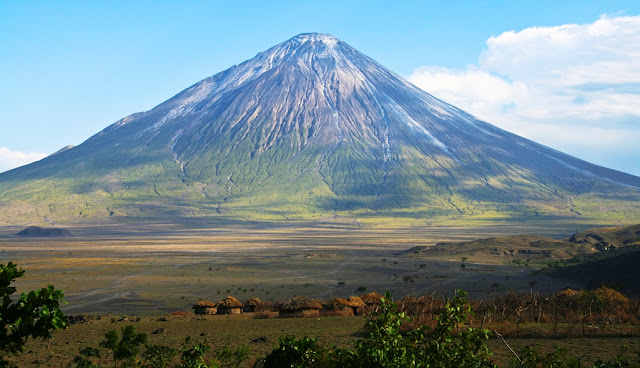The
Lake Natron is a salt and soda lake in the Arusha Region of Northern
Tanzania, close to Kenyan Border in Gregory Rift. The Lake is mainly fed
by Ewaso Ng’iro River, rises in central Kenya and by mineral-rich hot
springs. The water level varies depend on its water. The Lake Natron is
quite shallow just 9.8 feet deep, 57 KM long and 22 KM wide. The Lake
temperature is falling above 40 °C (104 °F). Due to its exclusive
biodiversity Tanzania has named The Lake Natron Basin to the Ramsar list
of Wetlands of International significance. The Lake Natron is also the
World Wildlife Fund East African halophytics ecoregion. The Lake has
high levels of evaporation left behind natron, and trona (sodium,
carbonate, decahydrate, sesquicarbonate dehydrate).
The
Lake alkalinity reach a pH of more than 12, make surrounding bedrock is
composed of alkaline, sodium-dominated trachyte lavas that were laid
down during the Pleistocene period. Due to high evaporation rates, the
color of lake is characteristic during the dry season, salinity levels
rises at a certain point where the salt loving microorganisms starts to
flourish. Therefore, halophile organisms include few cyanobacteria that
make their own food with photosynthesis as plants do. Moreover,, the red
accessory photosynthesizing pigment in the cyanobacteria yields the
deep reds of the open water of the lake and the orange colors of the
shallow parts of the lake. The alkali salt crust on the surface of the
lake is also every so often colored red or pink by the salt-loving
microorganisms that live there. There’re variety of plants surroundings
the lake gets benefits of salt marshes and freshwater wetlands. The Lake
Natron is home to some endemic algae, invertebrates, birds and fish.
Sometimes,
Lake Natron temperature crosses 60 °C make the life difficult for
animals and birds. The birds take advantage of the lake’s extreme
conditions, which keep their predators at bay, and more than 2.5 million
lesser flamingos flock there during breeding season. Three-quarters of
the world population of lesser flamingos (Hoenicopterus minor) live in
East Africa and use Lake Natron as their nesting site. Every year
countless lesser flamingos have flocked to Tanzania's Lake Natron to
start nesting, but mainly depend on the combination of environmental
factors. The gathering is one of nature’s fantastic spectacles. It’s a
regular breeding area of 2.5 million flamingoes, whose status is close
to “near-threatened” on the ICUN Red List. These flamingoes, gather
along nearby saline lakes to feed on a blue green algae with red
pigments, called “spirulina”.
The
high salinity & cyanobacteria support more nests; as greater
flamingoes breed on mud flats, also it is a safe breeding place due to
its caustic environment is a barrier against predators trying to reach
their nests on seasonally forming evaporates islands. When the water
level is just right, salt islands are exposed in the center of the lake,
given that the impeccable nesting site. However, if the Lake is too
dry, predators are able to reach the young birds and eaten them, and if
there is too much rain, the nests can be flooded, so the conditions must
be perfect for a successful breeding season. Moreover, there are two
endemic fish species; the alkaline tilapias Alcolapia latilabris and A.
ndalalani flourish in lake water at the edges of hot spring inlets. The
surrounding area is not inhabited but some herding and seasonal
cultivation take place. Further, there are a number of campgrounds near
the lake, which is also the base for climbing Ol Doinyo Lengai. The Lake
Natron also provides support for 100,000 other water birds, many of
which are Palearctic migrants.
Moreover,
The most interesting, strange thing about this lake are the solitary,
mummified birds which can be sporadically found along its shoreline,
calcified over a long period of time and turned into fossils. The
surrounding area of Lake Natron contain some of the most astonishing
scenery in Africa also a home to some wildlife, the occasional giraffe
or zebra warthogs and many more. The other attraction in the area are:
the Mountain “Ol Doinyo Lengai”, the combination of broad open plains,
sheer rift escarpments, enormous freestanding volcanoes and the vast
multi-coloured soda lake itself is a home to a fascinating eco-system
which thrives in this severe environment is absolutely magnificent.
The
construction of dike at north end of lake and planned hydroelectric
power plant on the Ewaso Ng’iro in Kenya increases the threats of
dilution to this breading area may still be serious. Hence, there is no
formal protection. Another big threat is a proposed plan of soda ash
plant on its shores to pump the lake water to extract the sodium
carbonate to convert to washing powder, along with more than 100 workers
housing, and coal fired power station to provide energy for plant
complex. In addition, there is a possibility the developers may
introduce a hybrid brine shrimp to increase the efficiency of
extraction. Due to these threats, the lesser flamingoes continuing to
breed in the face of such mayhem is next to zero, and will leave lesser
flamingoes in extinction.

























































